Century: what is it, how to propagate, planting and care
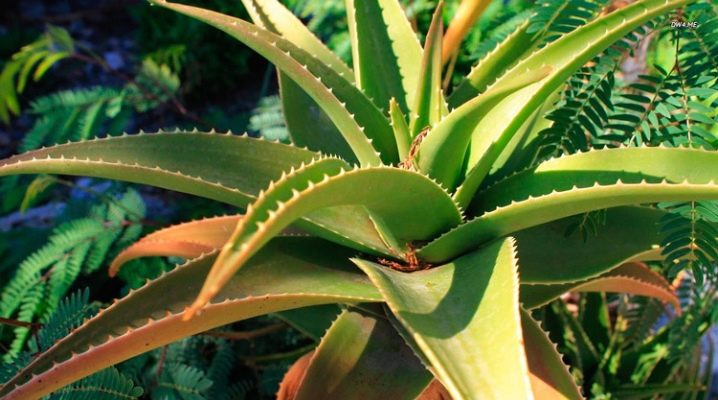
An ungainly simple plant with fleshy long thorny leaves on a crooked trunk was probably in every Soviet grandmother in the house. Later, this flower, which everyone knows as an agave, began to be considered a relic, so they tried to get rid of it. But in vain! After all, the agave, with all its unpretentiousness, still acts as a home doctor. But in order for the flower to be able to help, it must be properly grown and learned to cut only the required leaf plates. Therefore, today we will talk about how to care for an agave and what this plant is.
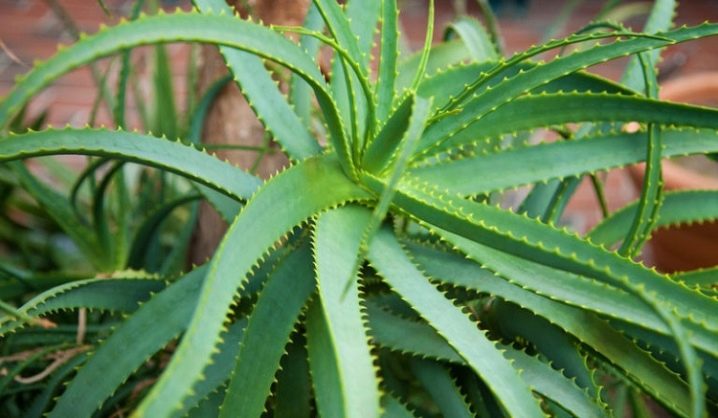
Description
Aloe arborescens (aloe tree) is the scientific name for the agave. The plant belongs to the Asphodelic family. His homeland is hot African countries: Zimbabwe, Mozambique, Somalia, Ethiopia. Here, the aloe looks like a tree, growing up to 3-5 m in height. Being a plant capable of well retaining water in its leaves, aloe feels comfortable in deserts and semi-deserts, on rocky soils.
In addition to tree species, shrub, herbaceous aloe are found in the natural environment. They also grow in the form of vines. In addition to Africa, the plant has spread to Madagascar and the Arabian Peninsula, the American continents. Aloe has taken root in the southern regions of Europe, the Mediterranean and Asia. As a cultivated plant, the aloe tree is grown in many places of growth. The reason is in useful properties. They have long been recognized by traditional medicine, so the agave is grown on an industrial scale and used for medical purposes and in cosmetology.

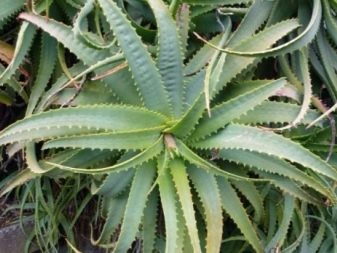
In home breeding conditions, this low tree up to 1 m in height can bush. The plant has a branched root that has a gray-orange color. The higher the plant, the more difficult it is for it to maintain its trunk in a straight position, since the leaves of the agave are very fleshy, juicy, reach 20-30 cm in length, give many lateral shoots. The leaf plates have sharp thorns along the edge, an elongated stem-embracing shape with a gel-like substance inside. The color of the leaves is from greenish-gray to dark green, they are covered with a waxy bloom. In the absence of water, aloe is able to conserve it by closing its own pores in the leaf plates.
From Arabic alloeh translates as "brilliant and bitter". Anyone who has ever tried juice or tincture with aloe can be convinced of this. When asked why the plant received the unofficial name "agave", there is an answer: it's all about the belief that a succulent blooms supposedly once every 100 years.
In fact, flowering and fruiting in the agave occurs every year or after a year, but only with careful care.
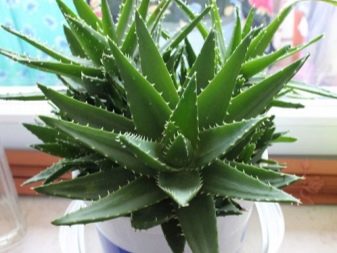
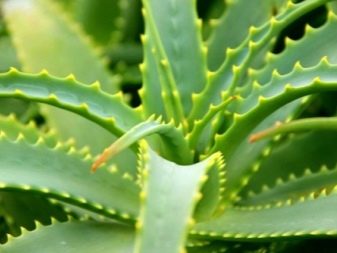
The centenary throws out a panicle or brush, the inflorescences are orange or sun-colored, coral, and sometimes white. Peduncle height is 20-40 cm, with a simple tubular perianth. The drooping bells are attached to thin pedicels. After flowering, the fruit remains in the form of a triangular capsule with numerous grayish-black seeds. At home, a flower can live up to 20 years, while not only supplying households with useful juice and pulp, but also reducing the number of bacteria in the house.
What is the correct name for a flower - aloe or agave? The answer is simple: the agave is one of the multivariate types of aloe. It's just that another popular species is a frequent guest in the house - aloe vera (aloe vera).This plant has practically no trunk at all, and its leaves are directed upwards. In all other respects, the difference is insignificant: aloe vera has fleshy leaves, and in terms of healing properties, real aloe overtakes the agave.
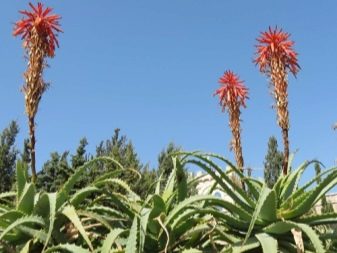
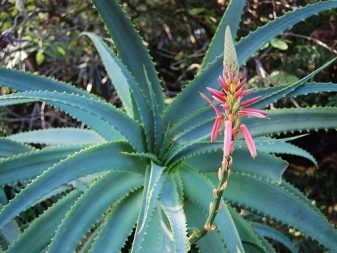
Views
Unfortunately, on some sites and forums you can find information that aloe vera (real) and agave are one and the same Mexican species. This is not so: the agave belongs to the Asparagus family, the Agave genus, the aloe belongs to the Asphodelic family, the Aloe genus. Therefore, they are different plants with similar properties. Aloe vera is widely used in cosmetology and medicine. There are still not so many domestic species that do not have pronounced medicinal properties, but are much brighter in appearance.
- Aloe variegated Is a tiger-colored plant with a very short stem.
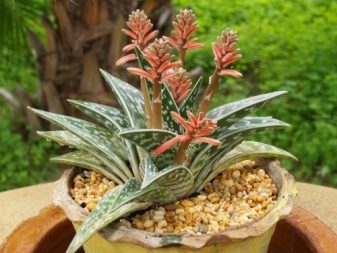

- Descoingsie - one of the smallest species.
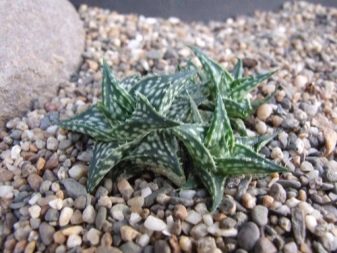
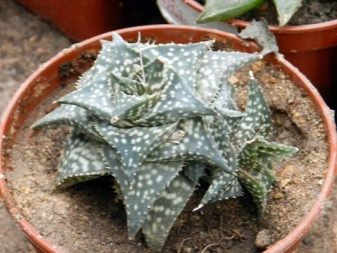
- Spinous - stemless plant with white thorns on the leaf surface.
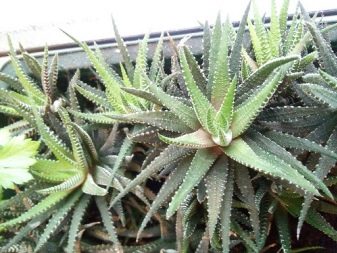
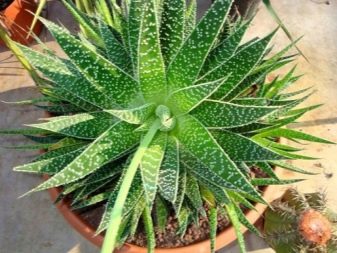
- Rauch - light spotted leaves turn red-brown from the bright sun.
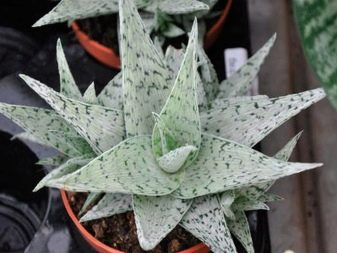
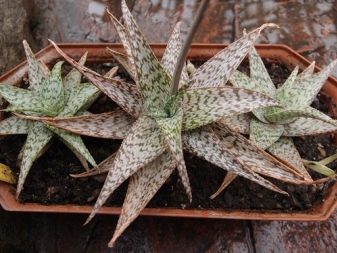
- Hedgehog - got thorns along the edge of the sheet. With age, they become almost black.
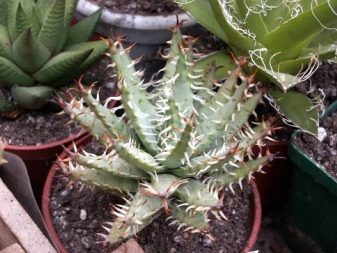
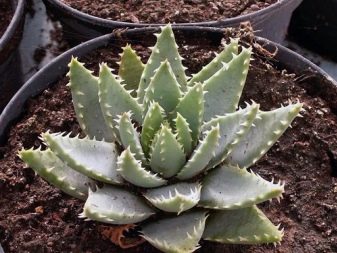
- Juvenile - mini aloe with triangular leaves.
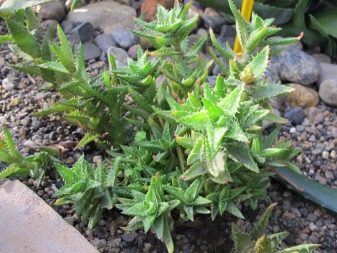
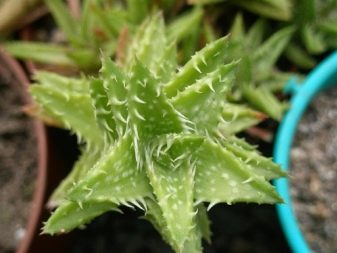
- Squat - a highly branching plant with upright, thorny leaves along the edges.
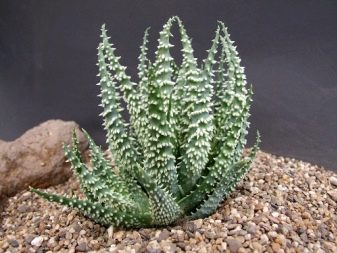
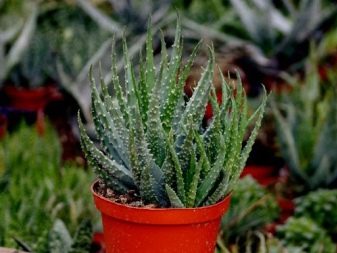
- Folded - a mighty aloe with a broken trunk, in nature reaching a height of 5 meters.

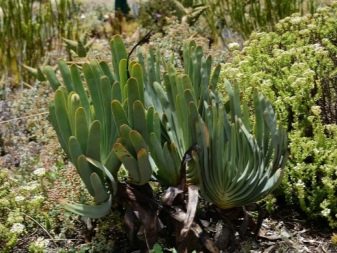
Landing
The centenary cannot be called a beautiful flower: it is spread out, with thorns along the edge of the leaf. To plant aloe, you need to attend to not only the place for the flower, but also the pot and the soil mixture. It is believed that the best flower pot is ceramic, breathable. It should not be too large, otherwise the plant will grow roots, not greenery. You can plant an agave in a ready-made mixture for succulents with the addition of chopped charcoal and pebbles. The mixture can be prepared independently: use 1 part of leafy soil, 2 parts of turf, 1 part of sand and 1 part of humus. Charcoal and fine minerals are worth adding, but not peat.
Sometimes, on purpose or accidentally, the plant loses its top or side shoot. If desired, such a piece without roots can also be planted. To do this, it is cooled for several hours (or days) on the lower shelf in the refrigerator, thus slowing down the vegetative processes and allowing the place of breakage (cut) to dry out. The stem with a pair of leaves is deepened into the prepared moist soil by 1-2 cm into the ground. To root the cutting faster, it is covered with a glass or plastic cap to maintain a constant temperature and humidity. Every day the flower is ventilated and moisturized.
The cap is removed when the plant has started to grow and new leaves have appeared.
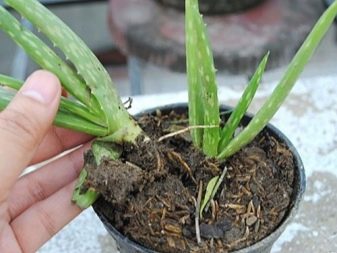
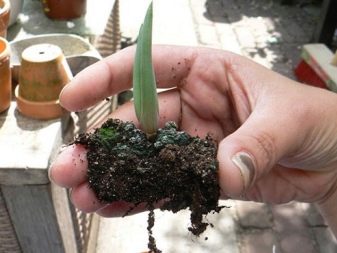
Care
To grow a medicinal plant at home, you need to know the rules of care, which include: watering, feeding, maintaining the required temperature, lighting.
- Watering the aloe properly is not watering it. The desert plant is watered no more than once a week in summer, and even less often in winter. Since there are much more roots in the pot than the soil, the water rushes directly into the sump during surface irrigation. Therefore, many recommend pouring water there, thin roots are able to absorb moisture through the drainage holes. After 30 minutes, the remaining liquid is discarded. The water should be at a temperature of 20-25 degrees. Aloe should be sprayed in the evening when the sun's rays do not hit the leaves. Shower him occasionally to wash the dust off the wide leaves.
- Lighting: the agave needs light, without it, the leaves will become soft, pale and elongated. The flower feels comfortable on the windowsills of the sunny side of the house. In summer, the plant is often taken outside and even transplanted into the ground during the warm season. Although not everyone approves of this method, as if rainwater gets in, the leaves can get burned.
- Temperature range: in summer, the optimal temperature for a flower is 18-25 degrees, which is why they try to take it outside, because in many houses these indicators are much higher. In winter, 10-14 degrees is enough.
- During the cultivation of the agave, it is regularly fed. But they do it from spring to autumn once a month. To do this, use poorly diluted mineral complexes for succulents. In winter, the flowers are not fed, otherwise they will stretch.
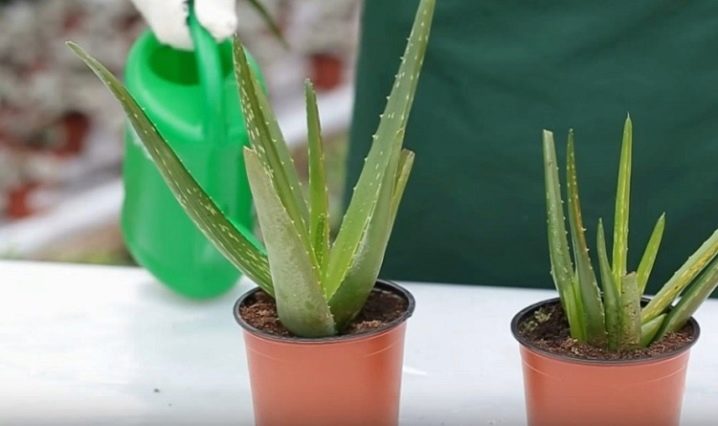
Important! Anyone who grows a plant for the sake of juice and pulp should know that the healing properties appear in the lower leaves only 3-4 years after planting.
Transfer
If the plant was bought in a peat pot, then it is recommended to leave it in this form for two weeks so that the flower can adapt to the new growing conditions. If a pot made of another material is filled with a nutritious substrate, then it will suit the plant within a year. It is recommended to replant young aloes once a year in late spring. At the age of 2-5 years - once every 2 years, formed flowers - once every 3 years. At the same time, it is important not to overdo it with humus - succulents do not need too fertile soil.
To transplant a flower, a 5-centimeter drainage layer in the form of pebbles, crushed brick, expanded clay must be laid on the bottom. The soil is used for succulents or cacti. When self-manufacturing the soil mixture, they take 4 parts of universal soil and 1 part of coarse river sand.
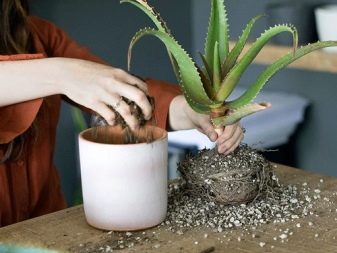
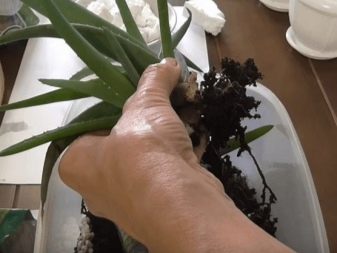
Then perform the following actions.
- The substrate is watered with warm, settled water.
- They make a hole in it. Pour some sand into it.
- A seedling is inserted, carefully deepening the roots. Sprinkle with earth mixture.
- If the plant is large, it is better to immediately tie it to a support.
- It is advisable to cover the flower with a plastic cap, leaving a hole above the ground for ventilation.
- Place the plant on a sunny kitchen windowsill.
- Remove the cap after the appearance of young leaves (after 2-3 weeks).
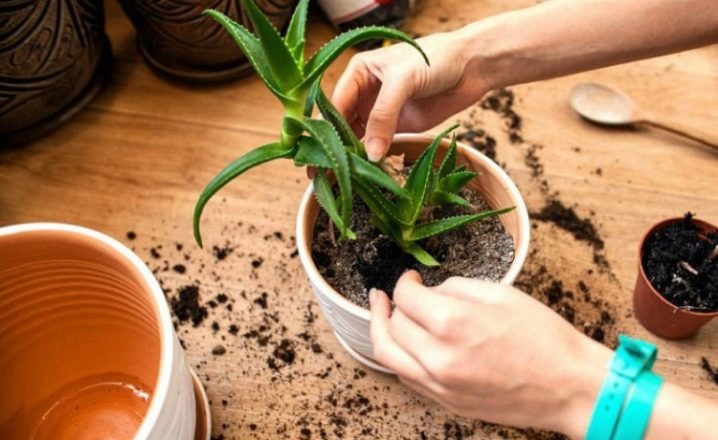
An adult plant is thoroughly shed with water a day before transplanting. When transplanting, the pot is turned over. An earthen lump is taken out of the old pot and transplanted into a new one on the drainage layer. The distance between the earthen lump and the walls of the pot is covered with earthen mixture. With any type of transplant, the appearance of young leaves indicates that the plant has taken root and started to grow.
Before rooting, it is very important to water the flower in moderation, the seedlings do not like excess moisture.
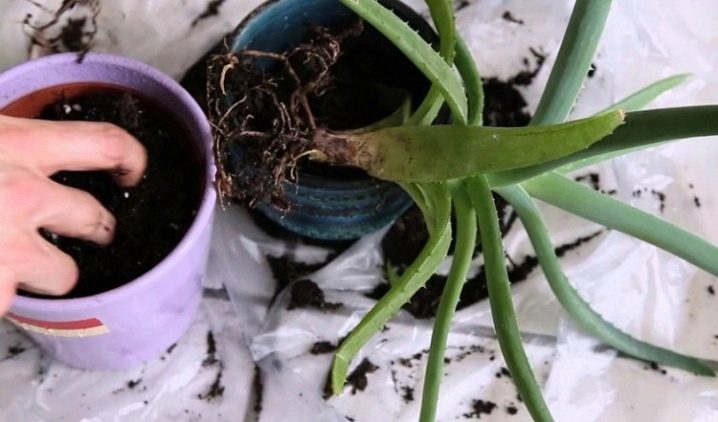
Reproduction
It is not very difficult to propagate the centenary. There are several ways, simple or more complex - you can choose depending on your desire and experience with plants. Aloe tree-like reproduces:
- seeds;
- leaves;
- lateral processes;
- young shoots (children).
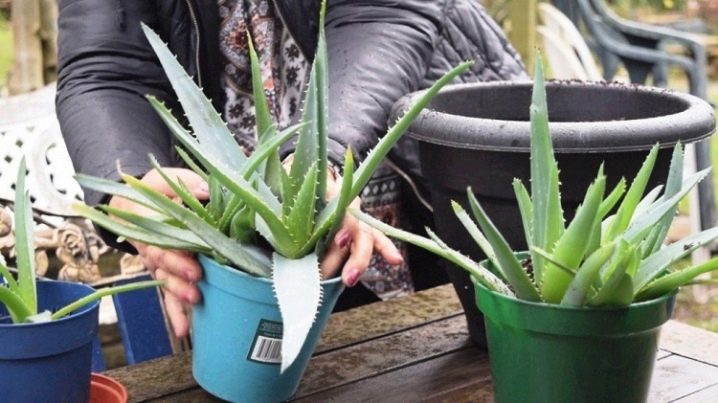
Seeds
The longest way. Seeds begin to be planted in late February - early March at an ambient temperature of + 21 degrees. For sowing, use a flat, low container with a substrate for aloe. The soil is evenly watered, the seeds are laid out on the surface and sprinkled with sand 1 cm thick. Before germination, the container is covered with polyethylene. Without opening the film, a greenhouse effect is created under it, so the land does not require watering.
Seedlings should appear in about 3-4 weeks, they are regularly sprayed with water. After regrowth of 3-4 true leaves, the seedlings should be planted in 5-centimeter cups. In summer, plants can be grown in an outdoor greenhouse, making sure that the seedlings do not get sunburn.
As you grow, you need to monitor the size of the pot: if the flower grows slowly, then transplant it after a year or earlier.


Leaves
Reproduction is carried out according to the same principle as planting with the top of the plant. The sheet is cut off from the trunk, sprinkled with crushed activated carbon to disinfect the cut line and left on a napkin for several days in a shaded place to dry. After 4-5 days, the leaf is planted in the ground. The bottom of the pot must be covered with drainage. The substrate is prepared typical of aloe.The sheet is pushed into moist soil to a depth of 5 cm at an angle of about 30 ° and covered with a cap (polyethylene, can). Rooting should take place in about 3 weeks, during which time the plant is regularly ventilated and watered several times.
The cap is removed after the aloe has produced young shoots.
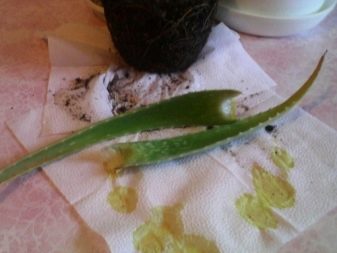
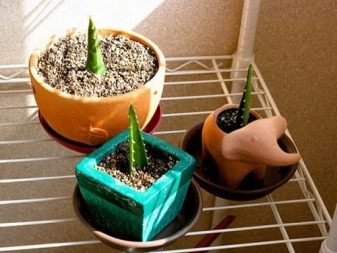
Lateral processes
A new plant is most often grown from the lateral process. The reason is that side shoots are constantly growing, they must be removed in a timely manner, and also because this is an easy and quick way to get a new plant. A shoot of 7-8 leaves is cut from an adult flower and dried for 4-5 days. The landing principle is the same as for the apical. But the leaves should not fall into the ground, otherwise children will sprout from them, which will thicken the plant. Either the lower leaves need to be cut off and the trunk is exposed to the planting depth.
Or sprinkle the soil with small stones and put the leaves on them. Rooting time is about a month.
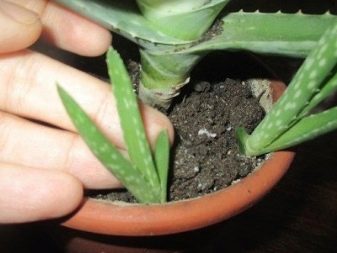
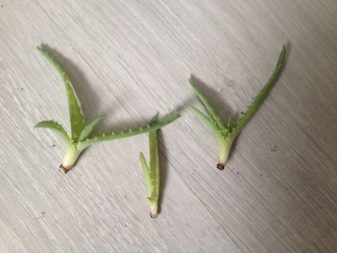
Children (root shoots)
For seedlings, you can use children with 3-4 leaves. They are removed from the adult plant with a sharp knife so that the children are separated from the roots. The prepared drainage and soil are watered and wait 30 minutes until excess water drains into the pan. The shoot is planted to a depth of 1 cm. The first decade is watered a little every day.
In about a month, new leaves should appear, which means that the seedling has taken root.

Possible problems
Flower can face three major challenges:
- insects are pests;
- fungal diseases;
- careless handling of the plant.
Aloe pests include spider mites, thrips, scale insects or false scales, mealybugs. In all cases, it is important not to start the plant at the first sign of atypical spots, cobwebs, wilting of the plant. Pests are fought with insecticides. For prophylaxis, the leaves of the plant are wiped with an alcohol napkin, once a month they are bathed in the shower. But when the first signs of any disease appear, the flower needs to be quarantined: set as far as possible from other plants.
In case of severe damage from a flower, healthy parts are removed and transplanted into new soil using a new pot. But the agave is not such a rare flower to take risks and cut off part of it for reproduction. Better to get rid of the diseased plant altogether. The most common fungal diseases are dry rot, in which the trunk turns black, the leaves lose their turgor and dry out. But the disease begins with drying out of the roots, therefore, with the manifestation of external signs, the flower is already deeply affected.
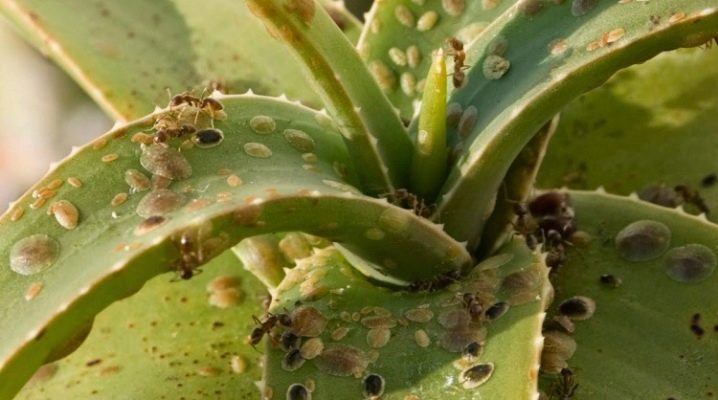
With root rot, the leaves become smaller, at first the tips turn yellow, and then the entire leaf. Gradually, the trunk of the plant rots and falls. You can save the top and grow a new flower from it. But it should be remembered that the mycelium is in the pot where the flower grew: experts advise throwing this container away. Or you can try to scald the pot with boiling water several times.
The reason for the appearance of root rot is the overflow of the plant. Leaves may turn yellow from this. Leaves curl from lack of moisture and general care: wipe the leaves with a damp cloth, feed the plant. The tips of the leaves begin to turn yellow and dry out, if the plant is cramped in the pot, it has not been transplanted for a long time. Also, flower growers may encounter the following problems when caring for an agave:
- the plant is stretched out, turned pale, the leaves are shrinking - it does not have enough light;
- the flower does not grow well, the leaves are soft - the composition of the soil is incorrectly selected;
- when using the juice extract, the expected medicinal properties are not observed - a young leaf is selected that has not yet reached 15 cm in length and does not possess these properties; the leaves must be cut off not earlier than three years of age in winter or spring, when the amount of active components in the leaf plate is maximum.
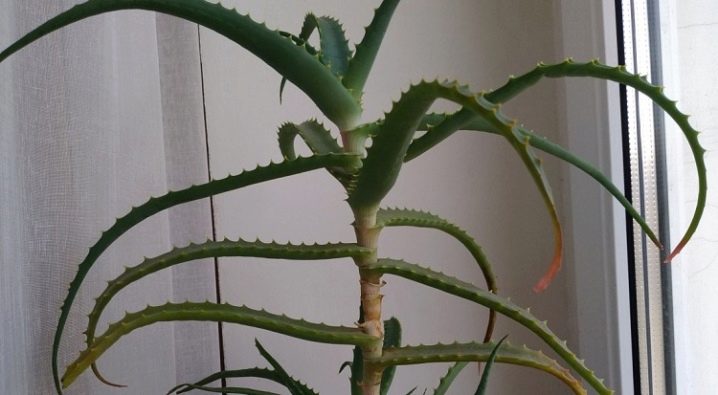
How to transplant a Stoletnik, see the video below.


















































The comment was sent successfully.